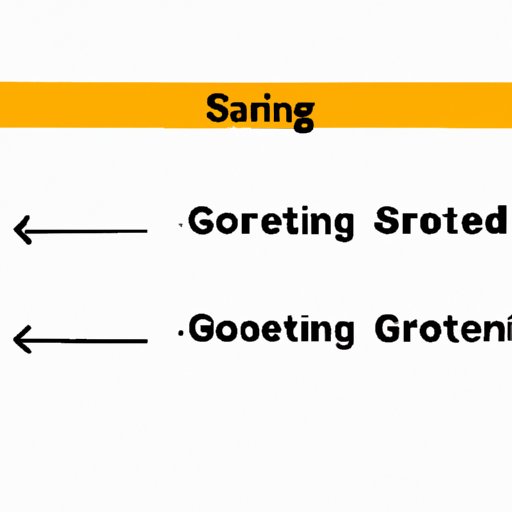I. Introduction
Sorting is a common operation in programming, and Go provides various techniques and libraries for sorting data. However, sorting in Go can be tricky, especially when dealing with slices of struct types or when custom sorting criteria are required. This article covers various techniques and examples for sorting in Go, including using the sort package, custom sorting functions, interfaces, string length sorting, stable sort, and concurrent sorting.
II. Sorting Slice of Integers Using the Sort Package
The sort package is a built-in package in Go that provides functionalities for sorting various types of data. Sorting a slice of integers is one of the simplest use cases for the sort package.
To sort a slice of integers in Go, we can use the sort package’s sort.Ints function. This function takes a slice of integers as an argument and sorts it in ascending order:
// create a slice of integers
numbers := []int{5, 2, 9, 3, 7}
// sort the slice in ascending order
sort.Ints(numbers)
// output: [2 3 5 7 9]
fmt.Println(numbers)
To sort a slice of integers in descending order, we can use the sort package’s sort.Sort function and pass a custom type that implements the sort.Interface interface. Here’s an example:
// define a custom type that implements sort.Interface
type reverseInts []int
func (r reverseInts) Len() int {
return len(r)
}
func (r reverseInts) Swap(i, j int) {
r[i], r[j] = r[j], r[i]
}
func (r reverseInts) Less(i, j int) bool {
return r[i] > r[j]
}
// create a slice of integers
numbers := []int{5, 2, 9, 3, 7}
// sort the slice in descending order
sort.Sort(reverseInts(numbers))
// output: [9 7 5 3 2]
fmt.Println(numbers)
III. Sorting Slice of Struct Types Using Custom Sorting Function
Sorting a slice of struct types can be more complicated than sorting a slice of integers, especially when sorting criteria other than the default ordering are required. In this case, a custom sorting function can be defined to provide the sorting criteria.
Here’s an example of how to sort a slice of struct types based on a custom sorting criteria using a custom sorting function:
// define a struct type
type Person struct {
Name string
Age int
}
// create a slice of Person structs
people := []Person{
{"Alice", 25},
{"Bob", 43},
{"Charlie", 19},
}
// define a custom sorting function
func sortByAge(people []Person) {
// bubble sort algorithm
for i := 0; i < len(people); i++ {
for j := 0; j < len(people)-i-1; j++ {
if people[j].Age > people[j+1].Age {
people[j], people[j+1] = people[j+1], people[j]
}
}
}
}
// sort the slice using the custom sorting function
sortByAge(people)
// output: [{Charlie 19} {Alice 25} {Bob 43}]
fmt.Println(people)
IV. Implementing Interfaces to Sort in Go
Go’s interface type allows sorting various types of data with a single sorting function. To implement an interface for sorting, a type must satisfy the sort.Interface interface by a) defining a Len method that returns the length of the data, b) defining a Less method that specifies the sorting criteria, and c) defining a Swap method that swaps two elements of the data.
Here’s an example of sorting a slice of struct types using the sort.Interface interface:
// define a struct type
type Person struct {
Name string
Age int
}
// define a slice of Person structs
people := []Person{
{"Alice", 25},
{"Bob", 43},
{"Charlie", 19},
}
// define a custom type that satisfies the sort.Interface interface
type ByAge []Person
func (b ByAge) Len() int {
return len(b)
}
func (b ByAge) Swap(i, j int) {
b[i], b[j] = b[j], b[i]
}
func (b ByAge) Less(i, j int) bool {
return b[i].Age < b[j].Age
}
// sort the slice using the sort.Interface interface
sort.Sort(ByAge(people))
// output: [{Charlie 19} {Alice 25} {Bob 43}]
fmt.Println(people)
V. Sorting a Slice of Strings Based on String Length
Sorting a slice of strings based on string length can be useful for applications that require this kind of sorting criteria. To sort a slice of strings based on string length in Go, we can use the sort package’s sort.Slice function and pass a custom less function that compares the length of two strings:
// create a slice of strings
words := []string{"hey", "hello", "hi", "hola", "hey there"}
// define a custom less function
func byLength(i, j int) bool {
return len(words[i]) < len(words[j])
}
// sort the slice using the custom less function
sort.Slice(words, byLength)
// output: [hi hey hola hello hey there]
fmt.Println(words)

VI. Performing a Stable Sort in Go Using Bubble Sort Algorithm
A stable sort algorithm is an algorithm that preserves the relative order of equivalent items in the sorted data. In Go, the sort package’s sort.Sort function performs an unstable sort, meaning equal items are not guaranteed to be sorted in their original order.
The bubble sort algorithm is a simple sorting algorithm that performs a stable sort. To perform a stable sort in Go, we can implement the bubble sort algorithm and use it with the sort.Sort function:
// define a slice of integers
numbers := []int{5, 2, 9, 3, 7, 2, 8}
// bubble sort algorithm function
func bubbleSort(numbers []int) {
for i := 0; i < len(numbers); i++ {
for j := 0; j < len(numbers)-i-1; j++ {
if numbers[j] > numbers[j+1] {
numbers[j], numbers[j+1] = numbers[j+1], numbers[j]
}
}
}
}
// sort the slice using the bubble sort algorithm function
bubbleSort(numbers)
sort.SliceStable(numbers, func(i, j int) bool {
return numbers[i] < numbers[j]
})
// output: [2 2 3 5 7 8 9]
fmt.Println(numbers)
VII. Implementing Concurrent Sorting in Go Using Goroutines and Channels
Concurrent sorting is a method of sorting that uses multiple CPUs or threads to sort the data faster. In Go, we can implement concurrent sorting using goroutines and channels.
To implement concurrent sorting in Go, we can divide the data into smaller chunks and sort each chunk concurrently using goroutines. Then we can merge the sorted chunks using a channel. Here’s an example:
// define a slice of integers
numbers := []int{5, 2, 9, 3, 7, 2, 8}
// define a function for sorting a chunk of data
func sortChunk(numbers []int, c chan []int) {
sort.Ints(numbers)
c <- numbers
}
// sort the slice using goroutines and channels
chunkSize := 2
chunks := make([][]int, 0)
for i := 0; i < len(numbers); i += chunkSize {
end := i + chunkSize
if end > len(numbers) {
end = len(numbers)
}
chunk := numbers[i:end]
chunks = append(chunks, chunk)
}
tempChan := make(chan []int)
for _, chunk := range chunks {
go sortChunk(chunk, tempChan)
}
var sorted []int
for i := 0; i < len(chunks); i++ {
sortedChunk := <-tempChan
sorted = append(sorted, sortedChunk...)
}
sort.Ints(sorted)
// output: [2 2 3 5 7 8 9]
fmt.Println(sorted)
VIII. Conclusion
Sorting in Go can be achieved using various techniques, including using the sort package, custom sorting functions, interfaces, string length sorting, stable sort, and concurrent sorting. Each technique has its advantages and disadvantages, depending on the specific use case. It’s important to consider the size and complexity of the data, as well as the performance requirements, when choosing a sorting technique in Go.
Hopefully, this article provides a useful reference for sorting in Go. For further reading, check out the official Go documentation on sorting and related packages, as well as other articles and tutorials on Go programming.
